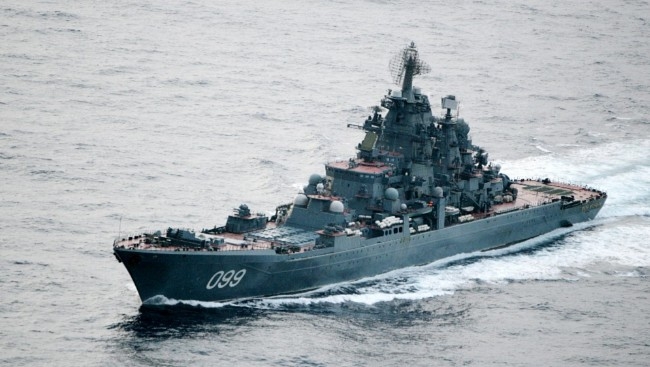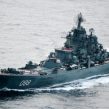
Russia’s Long-Term Naval Rearmament Plans
Publication: Eurasia Daily Monitor Volume: 11 Issue: 22
By:

President Vladimir Putin continues to support the creation of a modernized and combat-capable military by 2020. A significant element in such military modernization is the Navy, which also protects Russia’s interests in strategic areas from the Arctic to the Pacific Ocean; after more than two decades, the political leadership wants to seriously invest in a long-overdue naval modernization. Moscow is also increasingly turning its attention to the Asia-Pacific Region, and military manifestations of this policy appear in the building of military infrastructure in the Russian Far East and focusing naval modernization on the Pacific Fleet (https://voiceofrussia.com/news/2014_01_29/Pacific-region-arena-for-military-competition-of-largest-world-powers-2865/).
Russian experts and commentators are increasingly turning to consider precisely what type of Navy the country requires and whether these visions of its future match present political and economic rearmament plans. These themes also feature in the thinking of the General Staff (https://redstar.ru/index.php/component/k2/item/13774-gosoboronzakaz-strategiya-i-taktika). But these views and the likely trajectory of Russian naval development in the coming decades need to be defragmented from the high-profile reporting on increased activity in the Mediterranean Sea, including access to Cypriot ports for emergency use, to expose the harsh reality facing the Navy.
Konstantin Sivkov turned to such considerations as whether a quite limited naval capability is sufficient to solve the problem of ensuring military security. In Voyenno Promyshlennyy Kuryer, Sivkov interviewed Admiral (retired) Vladimir Komoyedov, the head of the Duma defense committee and former commander of the Black Sea Fleet. The interview itself contains little out of the ordinary, but it exposes some of the underlying issues concerning the reliability of current naval development plans: Do these plans correspond to the threat environment? If implemented, will naval modernization plans meet the needs of the country? (https://www.vpk-news.ru/articles/18748).
In order to define the type and size of a future Russian Navy, Komoyedov’s starting point is rooted in the size of the country and the need to maintain access to seas and oceans. He notes that the Navy faces stronger powers in both the western and eastern directions. Komoyedov asks if Moscow considers Russia to be a maritime power, because if so, the Navy must be equipped on the required scale. However, upon this very basis, Komoyedov slips into blue-water thinking; he outlines a future Navy replete with at least two aircraft carriers per fleet (https://www.vpk-news.ru/articles/18748). Such visions are way beyond the capacity of the domestic defense industry.
Despite Komoyedov’s blue-water naval aspirations, also frequently present in both official statements and analysis of the Navy, he does set some more realistic bounds. By 2020, in his view, the Navy will be able to solve the limited task of ensuring Russia’s military security in the seas and oceans; other missions and capabilities may prove to be more problematic. The priorities of naval rearmament should also not compete with or damage the real issues facing the economy, wages, pensions and jobs. Consequently, the political leadership must “solve a parallel set of tasks,” one of the most important will be the extent to which the ailing domestic defense industry may be successfully revived (https://www.vpk-news.ru/articles/18748).
Other critical commentaries in the Russian military press are more realistic on naval capabilities and the long-term future of the Navy, and it is interesting to contrast this with the blue-water thinking that Komoyedov illustrates. Maxim Shepovalenko, for example, reminds his readers that “after 1991” the Russian Navy lost its status as a fully oceanic force. Here there is no hint of blue-water thinking. The author recognizes the “low technical readiness” of the ships in the Navy and that significant numbers of these assets can only be considered as reserve status. Moreover, their complete overhaul is constrained by “limited financial, material and human resources.” To this impression of the current condition of the Navy is added the admission that “40 percent” to “70 percent” of ships are in need of repair and they are unfit for task; paradoxically the long sea voyages these make to generate publicity in the Russian media provide additional evidence of a mere shadow of the Soviet Navy, since they need to be accompanied by rescue tugs (https://vpk-news.ru/articles/18657).
Shepovalenko also provides some estimates on just how bad the present condition of the Russian Navy really is by offering an overall figure of around “40 combat-ready” surface ships. In the submarine forces there are no more than 39 combat ready submarines. According to the rearmament plans to 2020, the Navy should have 200 surface ships and submarines; and these estimates take into account an average service life for ships of around 35 to 40 years (https://vpk-news.ru/articles/18657).
In this sense, restoring the Navy and maintaining an oceanic status seems feasible; but the limited financial, material and human resources must concentrate on three main objectives, according to Shepovalenko. These are: strategic nuclear deterrence, non-nuclear deterrence, and the protection of national interests at sea. To achieve this, the focus must be placed on “maintaining a core combat fleet” or, in other words, nuclear missile and attack submarines and surface ships of the first and second ranks (https://vpk-news.ru/articles/18657).
Komoyedov and Shepovalenko offer widely differing visions of the future of the Russian Navy, and both have their distinctive understanding of its present condition. The persistence of blue-water thinking and generally unrealistic views among the top brass or former senior officers is essentially rooted in a false assumption: that the Russian Navy should compete with the United States Navy and restore some kind of nostalgic pride. Russia simply lacks the economic basis to even attempt such competition. However, a more realistic modernization is still problematic as it must actually resolve issues such as what naval structure is required, and how this will meet the challenges of the evolving strategic threat environment. Though under pressure to appeal to those clamoring for blue-water aspirations, the Kremlin appears to offer more limited naval modernization coupled with diplomacy to raise the flag and emphasize the country’s credentials as a great power—none of which leave the Navy with anything closely resembling real power-projection capabilities.




